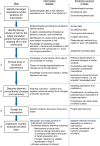Structural approaches for prevention of sexually transmitted HIV in general populations: definitions and an operational approach
- PMID: 25204872
- PMCID: PMC4159948
- DOI: 10.7448/IAS.17.1.19052
Structural approaches for prevention of sexually transmitted HIV in general populations: definitions and an operational approach
Abstract
Introduction: Although biomedical HIV prevention efforts have seen a number of recent promising developments, behavioural interventions have often been described as failing. However, clear lessons have been identified from past efforts, including the need to address influential social, economic and legal structures; to tailor efforts to local contexts; and to address multiple influencing factors in combination. Despite these insights, there remains a pervasive strategy to try to achieve sexual behaviour change through single, decontextualized, interventions or sets of activities. With current calls for structural approaches to HIV as part of combination HIV prevention, though, there is a unique opportunity to define a structural approach to HIV prevention as one which moves beyond these past limitations and better incorporates our knowledge of the social world and the lessons from past efforts.
Discussion: A range of interlinked concepts require delineation and definition within the broad concept of a structural approach to HIV. This includes distinguishing between "structural factors," which can be seen as any number of elements (other than knowledge) which influence risk and vulnerability, and "structural drivers," which should be reserved for situations where an empirically established relationship to a target group is known. Operationalizing structural approaches similarly can take different paths, either working to alter structural drivers or alternatively working to build individual and community resilience to infection. A "structural diagnostic approach" is further defined as the process one undertakes to develop structural intervention strategies tailored to target groups.
Conclusions: For three decades, the HIV prevention community has struggled to reduce the spread of HIV through sexual risk behaviours with limited success, but equally with limited engagement with the lessons that have been learned about the social realities shaping patterns of sexual practices. Future HIV prevention efforts must address the multiple factors influencing risk and vulnerability, and they must do so in ways tailored to particular settings. Clarity on the concepts, terminology and approaches that can allow structural HIV prevention efforts to achieve this is therefore essential to improve the (social) science of HIV prevention.
Keywords: HIV prevention; Implementation; social drivers; structural approaches; structural drivers.
Figures
Similar articles
-
Prevention of sexually transmitted HIV infections through the President's Emergency Plan for AIDS Relief: a history of achievements and lessons learned.J Acquir Immune Defic Syndr. 2012 Aug 15;60 Suppl 3:S70-7. doi: 10.1097/QAI.0b013e31825e3149. J Acquir Immune Defic Syndr. 2012. PMID: 22797743 Review.
-
Dual HIV risk and vulnerabilities among women who use or inject drugs: no single prevention strategy is the answer.Curr Opin HIV AIDS. 2012 Jul;7(4):326-31. doi: 10.1097/COH.0b013e3283536ab2. Curr Opin HIV AIDS. 2012. PMID: 22498480 Free PMC article. Review.
-
Elimination of HIV transmission through novel and established prevention strategies among people who inject drugs.Lancet HIV. 2019 Feb;6(2):e128-e136. doi: 10.1016/S2352-3018(18)30292-3. Epub 2018 Dec 14. Lancet HIV. 2019. PMID: 30558843 Free PMC article. Review.
-
Prevention of sexually transmitted human immunodeficiency virus (HIV) infection in adolescents.Curr HIV Res. 2006 Apr;4(2):209-219. doi: 10.2174/157016206776055057. Curr HIV Res. 2006. PMID: 16611059 Review.
-
"Half plate of rice to a male casual sexual partner, full plate belongs to the husband": findings from a qualitative study on sexual behaviour in relation to HIV and AIDS in northern Tanzania.BMC Public Health. 2011 Dec 28;11:957. doi: 10.1186/1471-2458-11-957. BMC Public Health. 2011. PMID: 22202562 Free PMC article.
Cited by
-
HIV prevention cascade theory and its relation to social dimensions of health: a case for Nigeria.HIV AIDS (Auckl). 2019 Aug 21;11:193-200. doi: 10.2147/HIV.S210190. eCollection 2019. HIV AIDS (Auckl). 2019. PMID: 31686918 Free PMC article.
-
Mapping and characterising areas with high levels of HIV transmission in sub-Saharan Africa: A geospatial analysis of national survey data.PLoS Med. 2020 Mar 6;17(3):e1003042. doi: 10.1371/journal.pmed.1003042. eCollection 2020 Mar. PLoS Med. 2020. PMID: 32142509 Free PMC article.
-
What will it take for the Global Plan priority countries in Sub-Saharan Africa to eliminate mother-to-child transmission of HIV?BMC Infect Dis. 2019 Sep 16;19(Suppl 1):783. doi: 10.1186/s12879-019-4393-5. BMC Infect Dis. 2019. PMID: 31526371 Free PMC article.
-
Spatial Access and Willingness to Use Pre-Exposure Prophylaxis Among Black/African American Individuals in the United States: Cross-Sectional Survey.JMIR Public Health Surveill. 2019 Feb 4;5(1):e12405. doi: 10.2196/12405. JMIR Public Health Surveill. 2019. PMID: 30714945 Free PMC article.
-
Developing Measures of Pathways that May Link Macro Social/Structural Changes with HIV Epidemiology.AIDS Behav. 2016 Aug;20(8):1808-20. doi: 10.1007/s10461-016-1291-3. AIDS Behav. 2016. PMID: 26796384 Free PMC article.
References
-
- Thigpen MC, editor. Daily oral antiretroviral use for the prevention of HIV infection in heterosexually active young adults in Botswana: results from the TDF2 study; 6th IAS Conference on HIV Pathogenesis, Treatment and Prevention; 2011 Jul 17–20; Rome. 2011.
Publication types
MeSH terms
LinkOut - more resources
Full Text Sources
Other Literature Sources
Medical
Miscellaneous



